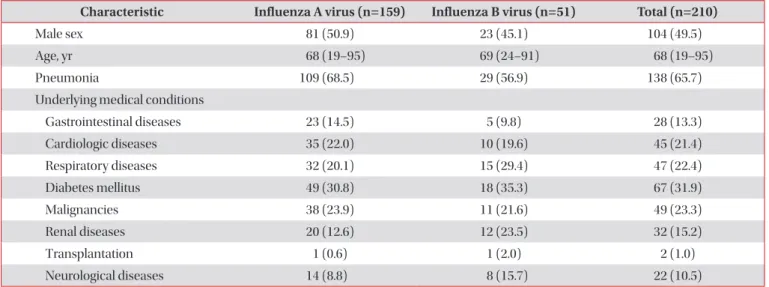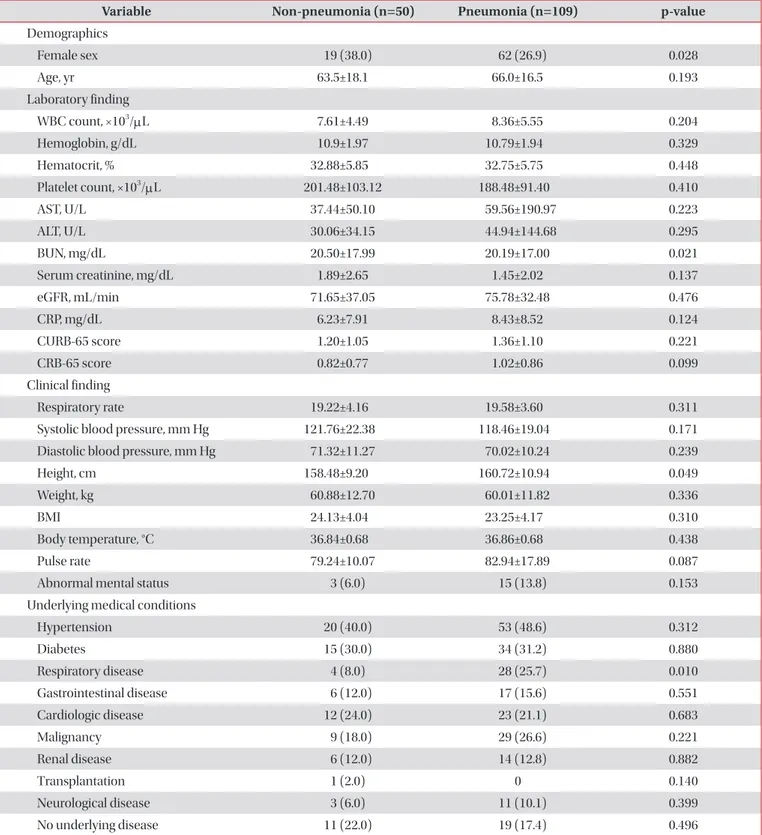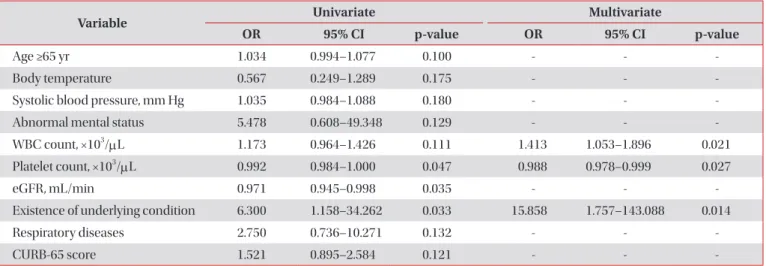Introduction
Influenza is a type of self-limiting disease characterized by acute onset of fever, sore throat, malaise, and respiratory symptoms. In healthy people, the disease resolves without any complications. However, considerable excess mortality is ob- served in elderly and comorbid patients
1. Although influenza combined with pneumonia can lead to death, mortality is often caused by the aggravation of a preexisting disease such as bronchial asthma, chronic obstructive airways disease, and cardiovascular diseases
2-4.
In the case of seasonal influenza, approximately 1% of hos- pitalized patients with combined influenza and pneumonia died between 2005 and 2008
5. From the 1976–1977 to the 2002–2003 seasons, 9.9 deaths per 100,000 attributed to
Incidence and Risk Factors of Pneumonia in Hospitalized Patients with Seasonal Influenza A or B
Seongjun Chu, M.D.
1,*, Sang Joon Park, M.D.
1,*, So My Koo, M.D.
1, Yang Ki Kim, M.D., Ph.D.
1, Ki Up Kim, M.D., Ph.D.
1, Soo-Taek Uh, M.D., Ph.D.
1, Tae Hyung Kim, M.D., Ph.D.
2and
Suyeon Park, Ph.D.
3Divisions of
1Pulmonary and Allergy Medicine and
2Infectious Disease, Department of Internal Medicine,
3Department of Biostatistics, Soonchunhyang University Hospital, Seoul, Korea
Background: Most patients with influenza recover spontaneously or following treatment with an anti-viral agent, but some patients experience pneumonia requiring hospitalization. We conducted a retrospective review to determine the incidence and risk factors of pneumonia in hospitalized patients with influenza A or B.
Methods: A total of 213 patients aged 18 years or older and hospitalized with influenza between January 2012 and January 2015 were included in this study. A reverse-transcriptase polymerase chain reaction assay was used to detect the influenza A or B virus in the patients’ sputum samples. We collected demographic and laboratory data, combined coexisting diseases, and radiologic findings.
Results: The incidence of pneumonia was higher in patients in the influenza A group compared to those in the influenza B group (68.6% vs. 56.9%), but this difference was not statistically significant. The presence of underlying respiratory disease was significantly associated with pneumonia in the influenza A group (adjusted odds ratio [OR], 3.975; 95%
confidence interval [CI], 1.312–12.043; p=0.015). In the influenza B group, the white blood cell count (adjusted OR, 1.413;
95% CI, 1.053–1.896; p=0.021), platelet count (adjusted OR, 0.988; 95% CI, 0.978–0.999; p=0.027), and existence of an underlying medical disease (adjusted OR, 15.858; 95% CI, 1.757–143.088; p=0.014) were all significantly associated with pneumonia in multivariate analyses.
Conclusion: The incidence of pneumonia was 65.7% in hospitalized patients with influenza A or B. The risk factors of pneumonia differed in hospitalized patients with influenza A or B.
Keywords: Pneumonia; Influenza; Risk Factors; Comorbidity
Address for correspondence: Soo-Taek Uh, M.D., Ph.D.
Division of Pulmonary and Allergy Medicine, Department of Internal Medicine, Soonchunhyang University Hospital, 59 Daesagwan-ro, Yongsan-gu, Seoul 04401, Korea
Phone: 82-2-709-9482, Fax: 82-2-793-9965 E-mail: uhs@schmc.ac.kr
*Seongjun Chu and Sang Joon Park contributed equally to this work.
Received: Nov. 1, 2016 Revised: Feb. 21, 2017 Accepted: May. 15, 2017 Published online: Sep. 1, 2017
cc



